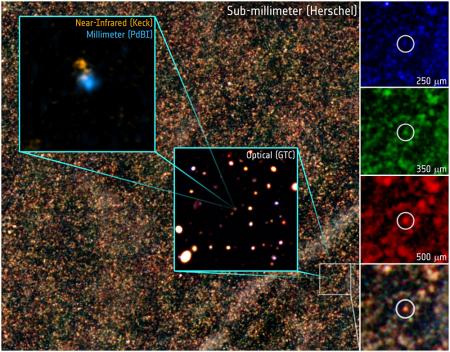

| Visitors Now: | |
| Total Visits: | |
| Total Stories: |

| Story Views | |
| Now: | |
| Last Hour: | |
| Last 24 Hours: | |
| Total: | |
Ancient Galaxy ‘Bursting’ with Stars

The galaxy HFLS3 appears as a small red dot in these Herschel submillimeter images (main image, and panels on right). Subsequent observations with ground-based telescopes, ranging from optical to millimeter wavelengths (insets), revealed two galaxies appearing very close together. The two are actually at very different distances, however, and HFLS3 (blue, in millimeter wavelengths) is so far away that we are seeing it as it was when the universe was just 880 million years old. Credit: ESA/Herschel/HerMES/IRAM/GTC/W.M. Keck Observatory.
Most of the early galaxies that astronomers have been able to observe are small with a low-to-moderate amount of star production. But now the Herschel Space Observatory has found a massive dust-filled galaxy churning out stars at an incredible rate, with all of this taking place back when the cosmos was a just 880 million years old. The galaxy is about as massive as our Milky Way, but produces stars at a rate 2,000 times greater, prompting the researchers to call it a “maximum-starburst” galaxy.
The astronomers involved in its discovery say its mere existence challenges our theories of galaxy evolution.
“Massive, intense starburst galaxies are expected to only appear at later cosmic times,” says Dominik Riechers, currently an assistant professor at Cornell. (…)
Read the rest of Ancient Galaxy ‘Bursting’ with Stars (477 words)
© nancy for Universe Today, 2013. |
Permalink |
No comment |
Post tags: galaxies, Herschel space observatory
Feed enhanced by Better Feed from Ozh
2013-04-17 15:17:34
Source: http://www.universetoday.com/101534/ancient-galaxy-bursting-with-stars/
Source:


